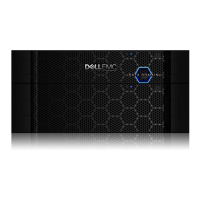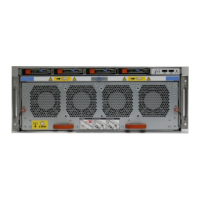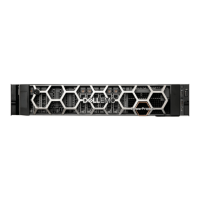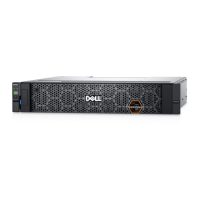Do you have a question about the Dell DR4100 and is the answer not in the manual?
Details front-panel components, buttons, and indicators like diagnostic, ID, power, and NMI.
Explains system conditions and corrective actions associated with health and hard-drive indicators.
Describes the hard-drive indicator patterns for activity and status.
Details back-panel components and indicators like system ID, iDRAC, PCIe slots, serial, and video connectors.
Explains the link and activity indicator codes for the Network Interface Card (NIC).
Details the power supply status indicator/handle and its patterns and conditions.
Provides step-by-step instructions on how to enter the system setup utility.
Lists and describes various configuration options available in the System Setup main menu.
Explains how to create and secure the system with system and setup passwords.
Lists keys and their actions for navigating the Boot Manager interface.
Explains the iDRAC settings utility for configuring iDRAC parameters via UEFI.
Provides general safety and operational notes for working inside the system.
Explains system memory specifications, types, and supported configurations.
Provides recommended guidelines for mixing and populating DRAM modules for best performance.
Provides steps and safety precautions for removing memory modules from sockets.
Provides steps and safety precautions for installing memory modules into sockets.
Explains how hard drives connect and safety precautions for hot-swap installation.
Provides steps and precautions for safely removing a hot-swap hard drive.
Provides steps and precautions for installing a hot-swap hard drive.
Introduces processor installation and removal procedures, including thermal considerations.
Details steps and safety precautions for removing a processor from its socket.
Details steps and safety precautions for installing a processor into its socket.
Introduces the system's power supply modules and redundancy features.
Details steps and precautions for removing an AC power supply unit.
Details steps for installing an AC power supply unit.
Introduces the system board and precautions for its removal and installation.
Details steps and precautions for removing the system board.
Details steps and precautions for installing the system board.
Provides steps for troubleshooting system startup issues and hangs.
Details steps for troubleshooting USB keyboard/mouse and other USB devices.
Details steps for troubleshooting Network Interface Card (NIC) connectivity and driver issues.
Details steps for troubleshooting hard drive issues, including RAID configurations.
Details steps for troubleshooting system memory problems, including seating and configuration.
Details steps for troubleshooting processor installation and functionality issues.
Introduces the embedded system diagnostics (ePSA) and its capabilities for hardware testing.
Provides steps on how to launch the embedded system diagnostics from Lifecycle Controller.
Details the system board jumper settings and their functions for system configuration.
Identifies and describes system board connectors and their purpose.
Provides steps to disable or clear system and setup passwords using a jumper.
Lists processor types and related technical specifications.
Lists memory architecture, module sockets, capacities, and RAM details.
Describes PCI Express bus type and expansion slot configurations.
Details environmental factors like temperature, humidity, and contamination limits.
Lists system error codes, messages, details, and recommended actions.
Explains warning messages that prompt user response before task continuation.
Describes messages issued by system diagnostic utilities.
Provides information on how to contact Dell for technical support and service.
Lists related Dell documentation and their purpose.
Details front-panel components, buttons, and indicators like diagnostic, ID, power, and NMI.
Explains system conditions and corrective actions associated with health and hard-drive indicators.
Describes the hard-drive indicator patterns for activity and status.
Details back-panel components and indicators like system ID, iDRAC, PCIe slots, serial, and video connectors.
Explains the link and activity indicator codes for the Network Interface Card (NIC).
Details the power supply status indicator/handle and its patterns and conditions.
Provides step-by-step instructions on how to enter the system setup utility.
Lists and describes various configuration options available in the System Setup main menu.
Explains how to create and secure the system with system and setup passwords.
Lists keys and their actions for navigating the Boot Manager interface.
Explains the iDRAC settings utility for configuring iDRAC parameters via UEFI.
Provides general safety and operational notes for working inside the system.
Explains system memory specifications, types, and supported configurations.
Provides recommended guidelines for mixing and populating DRAM modules for best performance.
Provides steps and safety precautions for removing memory modules from sockets.
Provides steps and safety precautions for installing memory modules into sockets.
Explains how hard drives connect and safety precautions for hot-swap installation.
Provides steps and precautions for safely removing a hot-swap hard drive.
Provides steps and precautions for installing a hot-swap hard drive.
Introduces processor installation and removal procedures, including thermal considerations.
Details steps and safety precautions for removing a processor from its socket.
Details steps and safety precautions for installing a processor into its socket.
Introduces the system's power supply modules and redundancy features.
Details steps and precautions for removing an AC power supply unit.
Details steps for installing an AC power supply unit.
Introduces the system board and precautions for its removal and installation.
Details steps and precautions for removing the system board.
Details steps and precautions for installing the system board.
Provides steps for troubleshooting system startup issues and hangs.
Details steps for troubleshooting USB keyboard/mouse and other USB devices.
Details steps for troubleshooting Network Interface Card (NIC) connectivity and driver issues.
Details steps for troubleshooting hard drive issues, including RAID configurations.
Details steps for troubleshooting system memory problems, including seating and configuration.
Details steps for troubleshooting processor installation and functionality issues.
Introduces the embedded system diagnostics (ePSA) and its capabilities for hardware testing.
Provides steps on how to launch the embedded system diagnostics from Lifecycle Controller.
Details the system board jumper settings and their functions for system configuration.
Identifies and describes system board connectors and their purpose.
Provides steps to disable or clear system and setup passwords using a jumper.
Lists processor types and related technical specifications.
Lists memory architecture, module sockets, capacities, and RAM details.
Describes PCI Express bus type and expansion slot configurations.
Details environmental factors like temperature, humidity, and contamination limits.
Lists system error codes, messages, details, and recommended actions.
Explains warning messages that prompt user response before task continuation.
Describes messages issued by system diagnostic utilities.
Provides information on how to contact Dell for technical support and service.
Lists related Dell documentation and their purpose.











